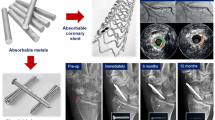Abstract
Device-related infections have been a big problem for a long time. This paper describes a new method to inhibit bacterial growth on implanted device with tissue-penetrating X-ray radiation, where a thin m etallic film deposited on the device is used as a radio-sensitizing film for bacterial inhibition. At a given dose of X-ray, the bacterial viability decreases as the thickness of metal film (bismuth) increases. The bacterial viability decreases with X-ray dose increases. At X-ray dose of 2.5 Gy, 98 % of bacteria on 10 nm thick bismuth film are killed; while it is only 25 % of bacteria are killed on the bare petri dish. The same dose of X-ray kills 8 % fibroblast cells that are within a short distance from bismuth film (4 mm). These results suggest that penetrating X-rays can kill bacteria on bismuth thin film deposited on surface of implant device efficiently.




Similar content being viewed by others
References
Barth E, Myrvik QM, Wagner W, Gristina AG. In vitro and in vivo comparative colonization of Staphylococcus aureus and Staphylococcus epidermidis on orthopaedic implant materials. Biomaterials. 1989;10(5):325–8.
Hetrick EM, Schoenfisch MH. Reducing implant-related infections: active release strategies. Chem Soc Rev. 2006;35(9):780–9.
Petty W, Spanier S, Shuster JJ, Silverthorne C. The influence of skeletal implants on incidence of infection. Experiments in a canine model. J Bone Joint Surg Am. 1985;67(8):1236–44.
Zimmerli W, Moser C. Pathogenesis and treatment concepts of orthopaedic biofilm infections. FEMS Immunol Med Microbiol. 2012;65(2):158–68.
Hickok NJ, Shapiro IM. Immobilized antibiotics to prevent orthopaedic implant infections. Adv Drug Deliv Rev. 2012;64(12):1165–76.
Niska JA, Meganck JA, Pribaz JR, Shahbazian JH, Lim E, Zhang N, et al. Monitoring bacterial burden, inflammation and bone damage longitudinally using optical and μCT imaging in an orthopaedic implant infection in mice. PLoS ONE. 2012;7(10):e47397.
Kurtz S, Ong K, Lau E, Mowat F, Halpern M. Projections of primary and revision hip and knee arthroplasty in the United States from 2005 to 2030. J Bone Joint Surg Am. 2007;89(4):780–5.
Lowy FD. Staphylococcus aureus infections. N Engl J Med. 1998;339(8):520–32.
Darouiche RO. Treatment of infections associated with surgical implants. N Engl J Med. 2004;350(14):1422–9.
Simon-Deckers A, Brun E, Gouget B, Carrière M, Sicard-Roselli C. Impact of gold nanoparticles combined to X-ray irradiation on bacteria. Gold Bulletin. 2008;41:187–94.
Norman RS, Stone JW, Gole A, Murphy CJ, Sabo-Attwood TL. Targeted photothermal lysis of the pathogenic bacteria, Pseudomonas aeruginosa, with gold nanorods. Nano Lett. 2008;8(1):302–6.
Luo Y, Hossain M, Wang C, Qiao Y, An J, Ma L, et al. Targeted nanoparticles for enhanced X-ray radiation killing of multidrug-resistant bacteria. Nanoscale. 2013;5(2):687–94.
Turner AD, Lewis AM, Hatfield RG, Powell AL, Higman WA. Feasibility studies into the production of gamma-irradiated oyster tissue reference materials for paralytic shellfish poisoning toxins. Toxicon. 2013;72:35–42.
Turner AD, Hatfield RG, Powell AL, Higman W. Potential use of gamma irradiation in the production of mussel and oyster reference materials for paralytic shellfish poisoning toxins. Anal Bioanal Chem. 2010;397(2):743–9.
Hossain M, Su M. Nanoparticle location and material dependent dose enhancement in X-ray radiation therapy. J Phys Chem C Nanomater Interfaces. 2012;116(43):23047–52.
Hossain M, Luo Y, Sun Z, Wang C, Zhang M, Fu H, et al. X-ray enabled detection and eradication of circulating tumor cells with nanoparticles. Biosens Bioelectron. 2012;38(1):348–54.
Sahu SK, Kortylewicz ZP, Baranowska-Kortylewicz J, Taube RA, Adelstein SJ, Kassis AI. Strand breaks after the decay of iodine-125 in proximity to plasmid pBR322 DNA. Radiat Res. 1997;147(4):401–8.
Acknowledgments
This work is supported with a Director’s New Innovator Award (1DP2EB016572) from National Institute of Health. We thank Dr. Chaoming Wang for helpful discussions and some data analysis work.
Author information
Authors and Affiliations
Corresponding author
Additional information
Jincui An and An Sun have equal contributions to this article.
Rights and permissions
About this article
Cite this article
An, J., Sun, A., Qiao, Y. et al. Preventing bacterial growth on implanted device with an interfacial metallic film and penetrating X-rays. J Mater Sci: Mater Med 26, 68 (2015). https://doi.org/10.1007/s10856-014-5374-2
Received:
Accepted:
Published:
DOI: https://doi.org/10.1007/s10856-014-5374-2




